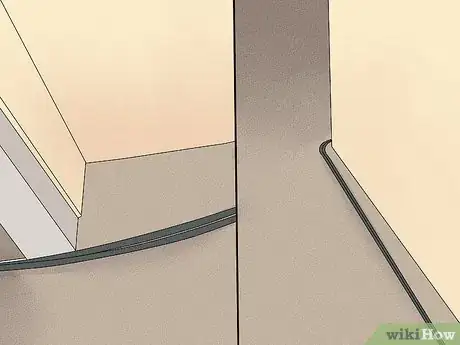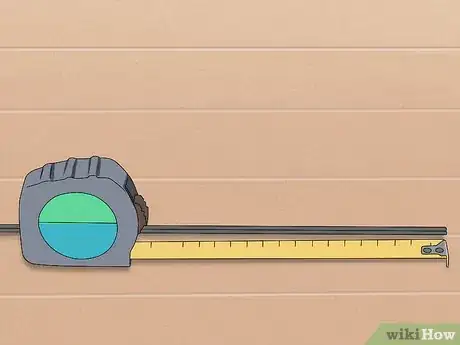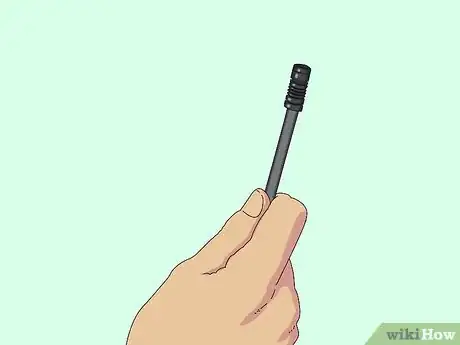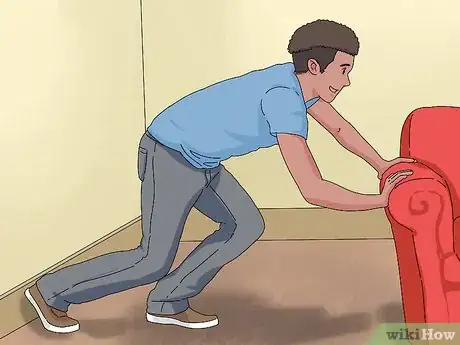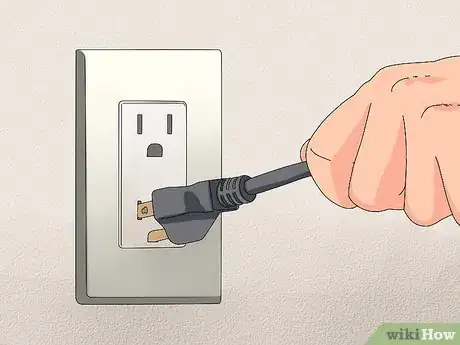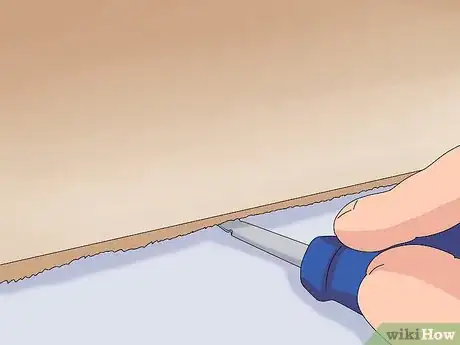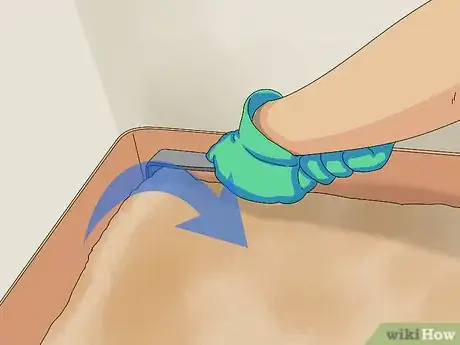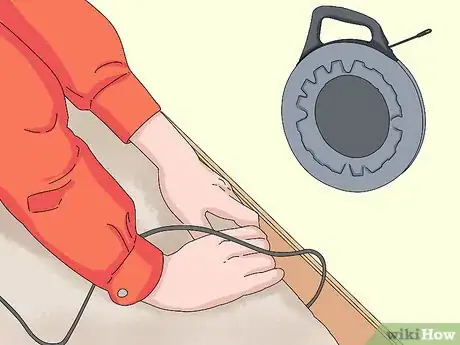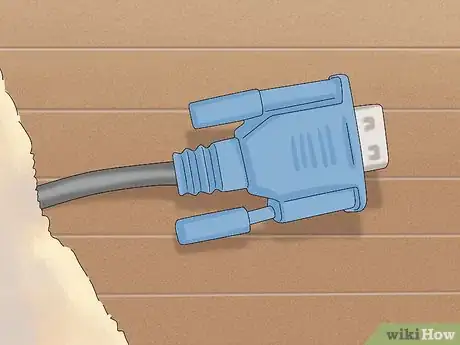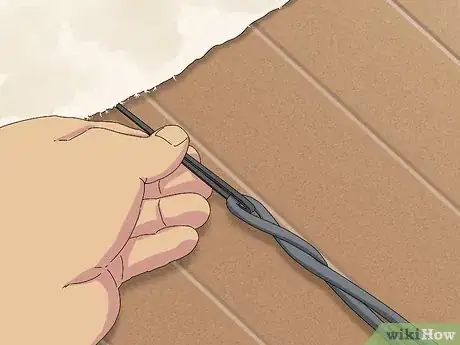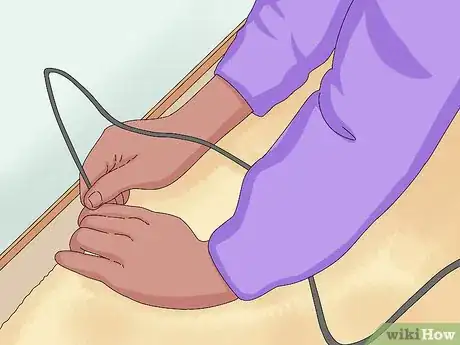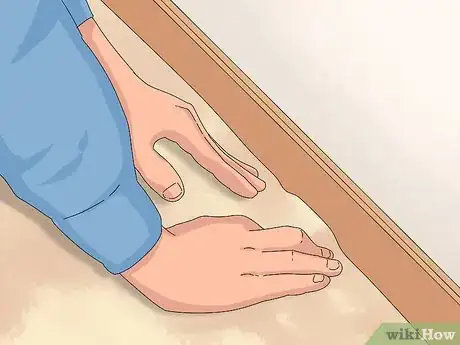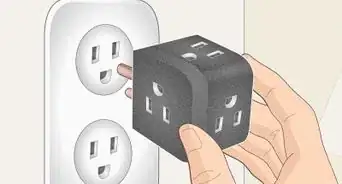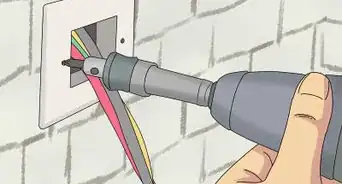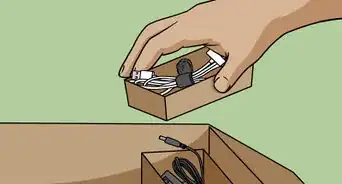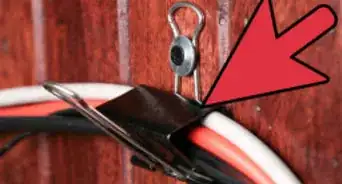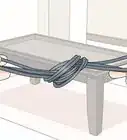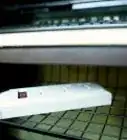This article was co-authored by Jacob Pischer. Jacob Pischer is a Home Improvement Specialist and the Owner of Helpful Badger, a home repair service in Portland, OR. With over four years of experience, Jacob specializes in a variety of handyman services including pressure washing, cleaning gutters, repairing drywall, fixing leaky plumbing fixtures, and repairing broken doors. Jacob studied at Madison Area Technical College and has a background in real estate investment.
There are 13 references cited in this article, which can be found at the bottom of the page.
This article has been viewed 92,934 times.
Exposed cables can be bothersome and unsightly. Running cables under carpet is an easy and effective way to stay connected without creating an eyesore in your home. Depending on the space you’re working with, the process of setting up your cables requires only a few tools, including a fish tape or a measuring tape, and pliers.
Steps
Preparing the Space
-
1Plan out the path for the cable. Decide whether to run the cable directly across the room from wall to wall, around the edge for longer cables, or in a pattern that will help avoid major foot traffic.
- It’s a good idea to make a careful decision about where you want to run your cable, to avoid creating a trip hazard. You may even want to make a sketch of the room before beginning to help you visualize the best spot to place the cable.
- Try to run the cables as close to the wall as possible so you won't step on them when you're walking. There may even be a hollow space there which will make it easy to tuck the cable out of sight.[1]
- Avoid placing the cable under heavy furniture, and try to minimize the distance that your cable has to travel.
-
2Measure the cable. Use a measuring tape or ruler to find the length of your cable, and compare it to the path you want the cable to take.
- This is especially important before you start installing the cable under the carpet, so that you avoid losing the cable underneath the carpet, or making any unnecessary incisions in your carpet.[2]
Advertisement -
3Check that the cables you’re using are safe to thread under carpet. Cables should be small so as not to cause a trip hazard, and should be non-flammable. Be sure to double check your building’s safety and fire codes before installing cables.[3]
- To tell if your cable is safe, check that the jacket or the outer layer of the cable is intact, and that there is no exposed wire.
- Most cable installation under carpeting should be completely safe, but if you're in the attic of an older home, check under the carpet for old electrical wiring before beginning this process, as you will want to avoid overlapping with these wires.
-
4Remove all furniture from the area. You will need to lift up the carpet along the path of the cable, so be sure to move any furniture that sits on the carpet for your safety and ease.[4]
- For larger furniture like sofas and coffee tables, it may be useful to enlist a friend's help in safely moving your furniture.
-
5Unplug the cable you want to use. It is important to ensure that the cable is detached from all appliances before running it under carpet in case it pulls on any heavy appliances.
- If one end of your cable is permanently attached to an appliance, use extra care when pulling the cable under the carpet, and be sure the device is switched to the "off" position.
-
6Loosen carpet liner if necessary. If you are running your cable along the edge of a carpet where it is held in place by a liner, use a flathead screwdriver to lift up the liner and pull the carpet up slightly along the edge to make space for the cable.[5]
- Do not completely remove the liner, but rather loosen it enough that you can pull up the carpet that is tucked underneath.
Guiding the Wire
-
1Pull up the carpet where you want to begin threading the cable. Try to lift only a small section of carpet up.[6] It may be helpful to use pliers to lift the carpet.
- If your cable is already permanently attached to an appliance, pull up the carpet on the opposite end of the path from where the attached cable is located. This ensures that you can pull the cable back through with ease later on in the installation process.
-
2Unwind a reel of fish tape and guide it under the carpet. Fish tape is a tool that is often used for routing wires. To use, simply unwind the reel, and the nylon or steel wire inside should get pushed out. Unwind the wire until it reaches the other side of the room, or the location where you want the cable to emerge from the carpet.[7]
- The wire from the fish tape should follow the same path where you would eventually like to place your cable.[8]
- It is helpful to lift the carpet up with your hand at the same time as you unwind the wire and guide it under the carpet. It may be helpful to ask a friend to assist you in lifting the carpet as you go.
- If you do not have fish tape handy, you can use a measuring tape instead. If you’re using a measuring tape, pull the measuring tape out and push it underneath the carpet along the path that you want the cable to take.[9]
-
3Lift the fish tape out from beneath the carpet on the other side of the room. If you are pulling the wire out near a wall, you can use pliers to slightly lift up the carpeting there. If you are hoping to pull the wire through the carpet, you can make a slight incision using a screwdriver or scissors where you want to pull the cable through.[10]
- If you are using a tape measure, make sure to switch it to the "locked" position so that the tape does not get pulled back through the carpet.
Pulling Through and Attaching
-
1Attach the cable to the fish tape. On the end of the fish tape that you just pulled out from under the carpet, there should be a hook which you can attach to your cable. It may be helpful to use a bit of tape to secure the cable to the end of the fish tape.
- If you are using a tape measure instead, try using duct tape to attach your cable to the end of the measuring tape.[11]
- Be sure the cable is securely attached to the fish tape or measuring tape so that you don’t lose the cable underneath the carpet and need to start over.
-
2Pull the tape back through the carpet by rewinding the fish tape reel. This should pull the cable under the carpet along the path that you made using the the fish tape. Do not stop until you have pulled the cable all the way through the desired path.
- Apply the same method if you're using a tape measure.[12]
-
3Detach the cable from the fish tape. Your cable should now run along your desired path underneath your carpet! You can now hook the cable up as you please.
-
4Reattach carpet liner if necessary. If you had to loosen your carpet liner to lift up the carpet, retighten it by hitting it gently with a mallet or hammer.[13]
- In pulling the carpet out, you may have also loosened nails in the floor. Use the hammer or mallet to gently tap on the carpeted area as well, to ensure that the nails are set back in place.[14]
Expert Q&A
Did you know you can get expert answers for this article?
Unlock expert answers by supporting wikiHow
-
QuestionWill I be able to tell there's a cable under the carpet?
 Jacob PischerJacob Pischer is a Home Improvement Specialist and the Owner of Helpful Badger, a home repair service in Portland, OR. With over four years of experience, Jacob specializes in a variety of handyman services including pressure washing, cleaning gutters, repairing drywall, fixing leaky plumbing fixtures, and repairing broken doors. Jacob studied at Madison Area Technical College and has a background in real estate investment.
Jacob PischerJacob Pischer is a Home Improvement Specialist and the Owner of Helpful Badger, a home repair service in Portland, OR. With over four years of experience, Jacob specializes in a variety of handyman services including pressure washing, cleaning gutters, repairing drywall, fixing leaky plumbing fixtures, and repairing broken doors. Jacob studied at Madison Area Technical College and has a background in real estate investment.
Home Improvement Specialist
Things You'll Need
- Fish tape or measuring tape
- Cable
- Duct Tape
- Pliers or flathead screwdriver
References
- ↑ Jacob Pischer. Home Improvement Specialist. Expert Interview. 4 September 2020.
- ↑ https://www.todayshomeowner.com/how-to-run-wires-in-existing-walls-and-floors/
- ↑ https://www.todayshomeowner.com/how-to-run-wires-in-existing-walls-and-floors/
- ↑ https://www.youtube.com/watch?v=eqx5f_xdf_Y&feature=youtu.be&t=48
- ↑ https://www.youtube.com/watch?v=ZnHTak0PQV0&feature=youtu.be&t=62
- ↑ https://www.youtube.com/watch?v=eqx5f_xdf_Y&feature=youtu.be&t=37
- ↑ https://www.youtube.com/watch?v=eqx5f_xdf_Y&feature=youtu.be&t=60
- ↑ https://www.youtube.com/watch?v=eqx5f_xdf_Y&feature=youtu.be&t=60
- ↑ https://www.youtube.com/watch?v=eqx5f_xdf_Y&feature=youtu.be&t=1
- ↑ https://www.youtube.com/watch?v=iN8_iULZMQA&feature=youtu.be&t=187
- ↑ https://www.youtube.com/watch?v=iN8_iULZMQA&feature=youtu.be&t=283
- ↑ https://www.youtube.com/watch?v=eqx5f_xdf_Y&feature=youtu.be&t=96
- ↑ https://www.youtube.com/watch?v=ZnHTak0PQV0&feature=youtu.be&t=723
- ↑ https://www.youtube.com/watch?v=ZnHTak0PQV0&feature=youtu.be&t=747
- ↑ https://www.youtube.com/watch?v=ZnHTak0PQV0&feature=youtu.be&t=136
- ↑ Jacob Pischer. Home Improvement Specialist. Expert Interview. 4 September 2020.
